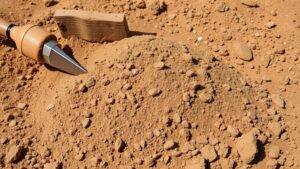Using Geophysical Surveys to Locate Hidden Silver Ore Bodies
Using Geophysical Surveys to Locate Hidden Silver Ore Bodies
The exploration for silver ore bodies presents unique challenges due to the often concealed nature of these valuable mineral deposits. To effectively locate hidden silver, geophysical surveys have emerged as a fundamental tool in the toolkit of mineral exploration. This article delves into the methodologies, advantages, and case studies illustrating the successful application of geophysical surveys in locating silver ore bodies.
Understanding Geophysical Surveys
Geophysical surveys encompass a range of techniques used to measure physical properties of the Earth’s subsurface. Methods such as magnetic, electrical, and seismic surveys provide critical data that can infer the location of mineral deposits. Each method leverages different physical properties, enabling geologists to map subsurface structures effectively.
- Magnetic Surveys: These surveys measure variations in the Earths magnetic field caused by the presence of ferromagnetic minerals often associated with silver deposits.
- Electrical Resistivity Surveys: This technique assesses how easily electric current can pass through subsurface materials, helping to differentiate between ore-bearing and non-ore-bearing rocks.
- Seismic Surveys: Utilizing sound waves, these surveys provide insights into geological structures, assisting in understanding the complex formations that may harbor silver ore.
The Role of Geophysical Surveys in Silver Exploration
Geophysical surveys allow for a non-invasive approach to exploring potential ore deposits, aiding in the process of generating geological models. They can help identify areas with high mineralization potential, thus optimizing the exploration effort.
According to the U.S. Geological Survey, the use of geophysical methods has significantly increased the success rate of mineral exploration, with a notable rise in the discovery of economically viable deposits. For silver, integrated geophysical data can lead directly to drilling programs that target specific areas predicted to contain ore.
Case Studies: Success Stories in Silver Exploration
A notable example of successful silver exploration through geophysical methods is the Penasquito Mine in Mexico. The use of a combined approach integrating airborne magnetic and electromagnetic surveys facilitated the discovery of extensive silver resources in the region. This integrated model allowed for targeted drilling, ultimately resulting in one of North Americas largest silver mines.
Another illustrative case is the San Cristobal deposit in Bolivia, where electrical resistivity surveys were pivotal in distinguishing between varying geological formations. This approach not only led to the identification of ore bodies but also informed the subsequent mining strategy.
Challenges and Limitations of Geophysical Surveys
Despite their advantages, geophysical surveys are not without challenges. Some limitations include:
- Resolution Issues: The depth of detection can vary significantly based on the method used, leading to potential gaps in data regarding deeper ore bodies.
- Geological Complexity: Areas with complicated geological structures may yield misleading results, necessitating further investigation.
Also, the effectiveness of geophysical surveys can be contingent upon the presence of specific geochemical indicators. Without complementary geological data, interpretations can be speculative.
Conclusion and Actionable Takeaways
The integration of geophysical surveys in the search for hidden silver ore bodies represents a significant advancement in mineral exploration. By utilizing various methods, such as magnetic, electrical, and seismic techniques, explorers can increase their chances of locating viable deposits while mitigating associated risks.
For practitioners and companies in the mining sector, the following takeaways may prove beneficial:
- Adopt a multi-faceted approach by combining different geophysical techniques to enhance exploration accuracy.
- Invest in advanced data analysis technologies to interpret geophysical survey results effectively.
- Maintain an interdisciplinary team, incorporating geologists, geophysicists, and data analysts to create comprehensive models.
To wrap up, by embracing the capabilities of geophysical surveys, mining companies can enhance their exploration efficiency, ultimately contributing to the global supply of silver.



